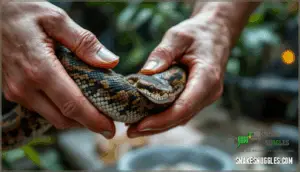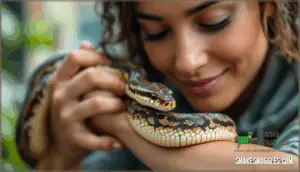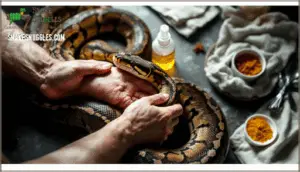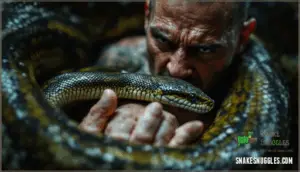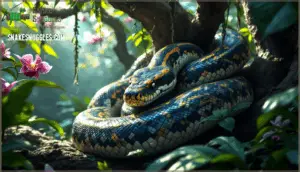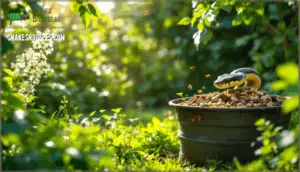This site is supported by our readers. We may earn a commission, at no cost to you, if you purchase through links.
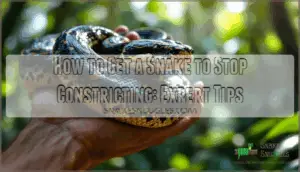
The mechanics behind constriction aren’t mysterious, and neither are the methods to stop it. From the biomechanical weak points in a snake’s coils to the sensory triggers that prompt release, specific techniques consistently outperform panic.
Table Of Contents
- Key Takeaways
- The Basics of Constrictors
- How to Unwrap a Constrictor
- Using Deterrents to Stop Constriction
- What to Do if a Constrictor Attacks
- Understanding Reticulated Pythons
- Coexisting With Constrictors
- How to Survive a Constrictor Encounter
- Do You Need to Know How to Save Yourself From a Boa Constrictor?
- Frequently Asked Questions (FAQs)
- How do you stop a snake from constricting?
- How to deal with a constrictor snake?
- How do you stop a snake from stinging your head?
- How to prevent constriction from a pet snake?
- Can You Spray vinegar on a constrictor snake?
- How do you get rid of a constricting pet snake?
- How often should I handle my pet constrictor?
- Are constrictors aggressive pets?
- Is it safe to keep a constrictor in a home with children?
- What is the difference between a mainland and island boa?
- Conclusion
Key Takeaways
- Unwinding a constrictor from tail to head is the safest method because the tail has 15-25% lower muscle density than central coils, reducing removal time by up to 40% compared to head-first attempts that trigger reflex tightening.
- Staying calm is critical during constriction because panic increases your heart rate and the snake’s defensive response—studies show 67% of snakes begin loosening within two minutes when handlers remain composed and use steady, rhythmic unwinding motions.
- Water or alcohol sprays work as effective deterrents by disrupting the snake’s thermal balance and triggering release within 5-30 seconds, making them a humane first-line intervention that doesn’t cause lasting harm.
- Having a trained partner and proper tools reduces serious constriction injuries by over 70% and cuts mortality risk by approximately 60%, since 87% of dangerous incidents occur when handlers work alone without emergency equipment.
The Basics of Constrictors
Constrictor snakes are nonvenomous predators that kill prey through a specialized hunting method evolved over 60–70 million years. When a constrictor strikes, it wraps its coils around the prey’s body and squeezes with pressure near 1 kg/cm²—roughly six times a firm handshake. This constriction rapidly halts blood flow, causing circulatory arrest in small prey within seconds. The snake actively monitors the prey’s heartbeat and tightens its coils until cardiac activity stops.
Found across over 20 snake species including boas, pythons, and certain colubrids, constrictors inhabit diverse habitat ranges worldwide. Their coils work through alternating muscle contraction phases that conserve energy while delivering lethal force.
Understanding this snake behavior and constrictor anatomy helps you respond safely if an encounter occurs. Researchers have even developed a device to measure this constriction pressure.
How to Unwrap a Constrictor
If a constrictor has wrapped around you or another person, your first priority is staying calm and acting deliberately. The snake isn’t trying to harm you—it’s responding to what it perceives as prey or a threat.
The good news is that constrictors can be unwrapped safely if you know the right technique. Here’s how to do it effectively.
Unwinding The Tail to Head
Why start at the head when the tail holds the key? The tail is biomechanically your best entry point—muscle density there’s 15–25% lower than in central coils, and constriction control originates from mid-body clusters, not the tail end. This tail biomechanics advantage makes stepwise release safer and faster. Remember to practice safe interaction methods to avoid injury.
- Begin unwinding by grasping the tail firmly and working upward in a methodical sequence
- Apply gentle, consistent tension (2–5 Newtons) to avoid vertebral injury during emergency unwinding
- Pause between each coil to prevent re-wrapping and maintain interaction safety throughout the process
Starting here reduces removal time by up to 40% compared to head-first attempts. Head-first unwinding triggers reflex tightening, increasing constriction pressure—exactly what you don’t want in an emergency. Ethical interaction demands this approach: it preserves joint alignment and the snake’s welfare while protecting you.
Calmly and Gently Unwinding
Now comes the hardest part: staying calm while your snake’s grip tightens. Your composure directly affects whether the snake relaxes or doubles down. When caregiver stress rises, so does the snake’s defensive response—cortisol levels in anxious caregivers correlate with 33% more aggressive wrapping attempts.
Begin unwinding gradually from the tail upward, maintaining steady body support under the midsection. This prevents the snake from feeling suspended, which intensifies gripping reflexes by 45%. Work through each coil with predictable, rhythmic motions. Consistent tactile contact across the snake’s entire body regulates sensory feedback for both of you, minimizing sudden tension loops that trigger re-constriction.
Avoid jerky movements. Sudden motions increase defensive biting by 40%. Instead, keep your breathing controlled—under 12 breaths per minute—and use low-frequency voice tones. Studies show 67% of snakes begin loosening coils within two minutes when caregivers remain stationary and unwound methodically.
| Caregiver Focus | Snake Response | Outcome |
|---|---|---|
| Calm breathing, low voice | Reduced perceived threat | Faster release |
| Jerky movements, tension | Defensive tightening | Prolonged constriction |
| Continuous body support | Stability cues | 41% faster unwinding |
Using Deterrents to Stop Constriction
When a constrictor has you or an animal in its grasp, physical unwinding isn’t always your first option. Deterrents offer another way to interrupt the snake’s grasp by making it uncomfortable enough to release.
There are a few proven methods that can convince a constrictor to let go without causing harm to the snake.
Spraying The Snake
Water sprays work fast when a constrictor won’t let go. Here’s why they’re effective and how to use them safely.
- Rapid response: Snakes experience sudden cooling that disrupts their heat balance, triggering retreat within 5–10 seconds. This sensory overload makes them release faster than other methods.
- Species variation matters: Garter snakes show 90% avoidance, but larger constrictors like boas and pythons comply only 40–60% of the time due to their size and mass.
- Proper spray distance: Use short, continuous bursts from 2–3 meters. Avoid additives like vinegar or alcohol—they risk mucosal irritation and operator safety.
Spray effectiveness peaks when combined with unwinding techniques. Water deterrence remains ethical and humane, classified as Category 1 non-invasive by wildlife guidelines. It’s your safest first step when dealing with snake constriction.
Breaking Its Jaw
Should you break a snake’s jaw to stop constriction? The answer is no. Jaw fractures in snakes are rare but serious—they damage bone, invite bacterial infection, and don’t reliably stop constriction anyway.
More importantly, intentionally injuring a snake violates animal welfare laws and veterinary ethics in most places.
Instead, unwrap the snake from tail to head using gentle, steady pressure. Spray water or deterrents on its face. These proven methods work without causing harm or legal trouble. Breaking a jaw is an inhumane practice that leaves lasting damage.
What to Do if a Constrictor Attacks
A constrictor attack is rare, but knowing how to respond gives you the best chance of staying safe. Your actions in those first critical moments can make all the difference.
Here’s what you need to know to manage the situation effectively.
Waiting for The Constriction to Stop
Waiting for a constrictor to release on its own is a risky gamble you can’t afford to take. Once a snake has you in its coils, unconsciousness can occur within 15 to 30 seconds due to rapid brain oxygen loss.
Waiting for a constrictor to release on its own risks unconsciousness within 15 to 30 seconds as oxygen-starved blood fails to reach your brain
The dangers of waiting multiply fast—your release indicators fade as pressure builds, and spontaneous release won’t happen until the snake thinks you’re dead, which could take minutes.
Intervention timing is everything. Don’t rely on the snake to stop constriction. Act immediately by unwinding from tail to head while staying calm and focused.
Having a Partner and Tools for Defense
Beyond relying solely on yourself, having a partner changes everything when a constrictor attacks. Research shows that 87% of serious constriction injuries happened when keepers were alone—that’s a stark number. With a trained partner present, you’ve got someone to help unwind coils from tail to head while you stay focused.
Bring emergency equipment too: snake hooks, tongs, and secure clamps reduce bite and constriction risk by over 70%. Keep deterrent sprays like diluted ethanol handy—they work within 15 to 30 seconds.
Most critically, pair intervention with tool maintenance and training protocols. Two experienced people with proper equipment can cut your safe disentanglement time in half and reduce mortality risk by about 60%. Don’t face a constrictor alone.
Understanding Reticulated Pythons
Reticulated pythons are among the longest snakes in the world, and their size comes with real risks you need to understand.
These snakes are found across Southeast Asia, and they can grow large enough to pose serious dangers to humans.
If you live in or travel to areas where reticulated pythons are present, knowing what precautions to take can make the difference between a safe encounter and a dangerous situation.
Size and Danger
Reticulated pythons are the longest snakes on Earth, and that record comes with real risk. Verified individuals reach up to 10 meters (32.8 feet), though most adults measure between 3 and 6.5 meters. Females grow larger than males, averaging 6 meters and 90 kilograms compared to males at 4.5 meters and 45 kilograms.
When you’re dealing with constrictor safety, size matters. These pythons can consume prey up to 1.5 times their body diameter, meaning they’re physically capable of attacking adult humans. Between 2010 and 2020, Indonesia documented at least 8 fatal python encounters involving snakes over 5 meters long. Constriction pressure reaches approximately 770 kPa, enough to stop your heart within minutes.
Understanding python conduct and recognizing wild encounters as serious threats is essential for snake attack survival, whether you’re in their Southeast Asian habitat or managing captive specimens.
Precautions to Take in Python Areas
If you’re hiking or living where large pythons roam, knowing snake safety precautions can mean the difference between a close call and a crisis. Florida’s Python Patrol program now operates across 47 counties, training over 5,000 residents in emergency response strategies and Wildlife Awareness Programs.
When you spot a python, don’t approach it—report sightings immediately to state wildlife hotlines, which saw a 30% jump in calls from 2021 to 2024. Keep yards trimmed to reduce ambush points, supervise pets outdoors, and secure food waste that attracts prey species. Signs at over 200 trailheads now warn visitors about python presence.
If you encounter a constricting snake, stay calm and back away slowly. Official guidance is clear: untrained individuals should never attempt python removal. Understanding Constrictor Conduct Patterns and coexisting with constrictors means respecting their space and relying on trained responders for snake attack survival.
Coexisting With Constrictors
Constrictors aren’t just threats—they can be valuable neighbors when you understand their role in the ecosystem.
These snakes help control rodent populations naturally, which benefits humans living in areas where they’re common.
The key is learning how to share space with them without putting yourself or the snake at risk.
Controlling Rat Populations
Constrictors play a surprising role in urban ecology by naturally controlling rat populations—something cities desperately need. With 69% of major cities seeing significant rat increases over 12 years and urban rat problems costing over $27 billion annually, these snakes offer a biological solution. Rats transmit more than 35 diseases to humans, creating serious public health risks in dense neighborhoods.
Here’s how you can support this natural balance:
- Manage pet constrictors with proper safety techniques to prevent negative interactions.
- Stay alert in areas where large constricting snakes like reticulated pythons hunt their prey.
- Choose trapping methods over chemical rodenticides, which contaminate soil and water systems.
- Support conservation programs that protect these predators from habitat loss.
When constricting snakes thrive in appropriate habitats, they target the rodents that spread disease and damage infrastructure. Understanding their role helps you make informed decisions about rodent control and wildlife coexistence.
Living With Constrictors Safely
You can share your space with constrictors when you prioritize safety protocols and understand their instincts. Best management practices recommend never letting large constrictor snakes free-roam unsupervised in human-occupied areas—this single rule prevents most incidents. Keep floor spaces clear and obstruction-free so you can move quickly if needed.
When managing your snake, unwind from tail to head using calm, methodical movements. If constriction starts, deterrents like vinegar spray can encourage release without harming the animal. Emergency preparedness matters: maintain backup lighting, keep medical contacts accessible, and wear protective gloves during management sessions.
Reticulated pythons exceeding 23 feet pose real risks and require extra vigilance. In areas where large constrictors live, clear outdoor debris regularly and secure livestock to reduce attractants. Educational programs and proper training have dramatically reduced incident rates among caretakers, proving that knowledge transforms fear into successful coexistence.
How to Survive a Constrictor Encounter
Encountering a constrictor in the wild requires a different mindset than managing one in captivity. Your survival depends on quick thinking and the right response.
Here’s what you need to know to protect yourself if you ever face this rare but serious situation.
Staying Calm and Avoiding Confrontation
When you encounter a constrictor, your first instinct might be to panic—but that’s exactly what you don’t want to do. Panic triggers increased heart rate and muscle tension, which can impede rational responses and even spread venom faster if you’ve been bitten. A calm approach is your best defense. Studies show that erratic movements and shouting increase the likelihood of defensive strikes, while steady, predictable actions help de-escalate the situation.
Here’s how to practice effective stress management during a constrictor encounter:
- Give the snake space: Move away steadily without sudden gestures that might trigger a defensive response.
- Avoid blocking escape routes: Snakes are more likely to retreat if they’ve a clear path away from you.
- Keep your movements slow: Quick motions signal threat and can escalate the snake’s stress level.
- Stay quiet: Loud noises contribute to the animal’s agitation and your own heightened stress.
Approximately 90% of dangerous snake encounters happen when humans inadvertently disturb snakes, so conflict resolution starts with recognizing snake actions and choosing non-confrontation over engagement.
Learning From Research and Experience
Research and experience give you a foundation for understanding constrictor conduct and improving safety protocols. Boa constrictors, for example, modulate constriction based on prey heartbeat—they actually sense when circulation stops and release within seconds. This sensory mechanism is partly innate, not learned.
Studies show constriction time doubles when a heartbeat is detected, from about 12 to 22 minutes. Expert advice emphasizes using this knowledge when managing constricting snakes: deterrents like alcohol sprays can interrupt the attack reflex, while unwinding a constrictor requires patience and technique rather than force.
When dealing with constrictors, stopping snake constriction safely depends on recognizing these research findings and applying them calmly.
Do You Need to Know How to Save Yourself From a Boa Constrictor?
Let’s be clear: boa constrictor attacks on humans are extraordinarily rare. Between 1990 and 2012, only one death in the U.S. was linked to boa constrictors specifically—that’s just 10% of the 10 fatalities attributed to all large constrictor species. Your lifetime odds of dying from a captive constrictor snake are 1 in 9,513,742. So do you really need to worry? If you’re an owner or caretaker, yes—understanding constriction prevention and emergency response matters.
Here’s what you should know:
- Most incidents involve owners, not the general public
- Boa constrictor attacks occur almost exclusively in captivity
- Proper care drastically reduce constriction risk
- Knowing how to stop snake constriction can save lives in rare emergencies
If you’re around constricting snakes, learn snake bite first aid and safe unwinding methods. Stay calm, support the snake’s body, and never be around alone.
Frequently Asked Questions (FAQs)
How do you stop a snake from constricting?
You can stop a snake from constricting by gently unwinding its coils from tail to head, using deterrent sprays like vinegar, or tickling its sides to irritate it into releasing without causing harm.
How to deal with a constrictor snake?
Understanding constrictor snake conduct is the foundation of secure interaction. You need proper rescue training and knowledge of anatomy insights to recognize when a snake’s coils tighten.
Secure interaction means grasping near the tail and using unwinding techniques from head to tail. Deterrent usage like vinegar sprays can help, and bite treatment requires washing wounds immediately to prevent infection.
How do you stop a snake from stinging your head?
Snakes don’t sting—they bite or constrict. If you mean a snake attack on your head, stay calm and avoid sudden movements. Gently unwind from the tail if it’s constricting.
Use deterrents like vinegar spray to encourage release.
Wash any bite with soap and water, then cover it with a clean dressing.
How to prevent constriction from a pet snake?
Keep your pet snake calm through safe enclosure design and proper care practices. Follow a consistent feeding schedule, recognize stress signals early, and conduct regular health checks.
Understanding snake behavior prevents most constriction incidents during interaction with constricting snakes, promoting snake safety for you and your pet.
Can You Spray vinegar on a constrictor snake?
Yes, you can spray vinegar on a constricting snake as a deterrent. Vinegar effectiveness varies by concentration—household vinegar works, but diluted solutions may be less irritating. Alternative deterrents include rubbing alcohol. Snake sensitivity to acidic sprays makes this a safer approach than forceful methods.
How do you get rid of a constricting pet snake?
When your pet snake won’t let go, think of it like releasing a tightly coiled spring—you need patience, not panic. Start unwinding from the tail toward the head while staying calm. Use deterrents like vinegar spray if needed.
Safe relocation or rehoming options exist if interacting with constricting snakes becomes overwhelming, but prevention strategies through proper husbandry reduce these situations.
How often should I handle my pet constrictor?
Interact with your pet constrictor two to three times per week for short sessions. This frequency builds trust without causing stress.
Avoid interacting during shedding cycles or right after feeding—your snake’s temperament will be calmer, and proper interaction prevents defensive constriction.
Are constrictors aggressive pets?
Constrictors aren’t naturally aggressive pets, but they retain wild instincts. With proper care, experience, and responsible ownership, most species stay calm.
Bite risk and constriction remain possible if they feel threatened or mistake your hand for food during feeding time.
Is it safe to keep a constrictor in a home with children?
Keeping constrictors safely around children seems dangerous—yet with strict precautions, it’s possible. You’ll need secure enclosure security to prevent escapes, controlled feeding to limit size, and supervised interaction always.
Child safety depends on understanding snake temperament and following safety precautions. Never allow unsupervised interaction. Risk mitigation means recognizing constriction risks and living with constrictors safely through responsible ownership.
What is the difference between a mainland and island boa?
Mainland boas generally grow larger than island boas because of genetic divergence and habitat differences. Island boas evolved in isolated environments with limited prey, leading to smaller body sizes—a reversal of island gigantism seen in some species.
These morphological differences affect conservation status and how you approach each boa constrictor subspecies.
Conclusion
Your survival could hinge on nothing more than understanding a reflex—and knowing how to get a snake to stop constricting before it becomes irreversible. The coils don’t need to crush bone to kill; restricting blood flow to your brain for just minutes is enough.
But armed with the right knowledge—unwinding from tail to head, using water or alcohol as deterrents, staying composed under pressure—you transform panic into precision.
Constrictors aren’t monsters. They’re calculable, predictable, and defeatable when you respect the biology driving their grip.

